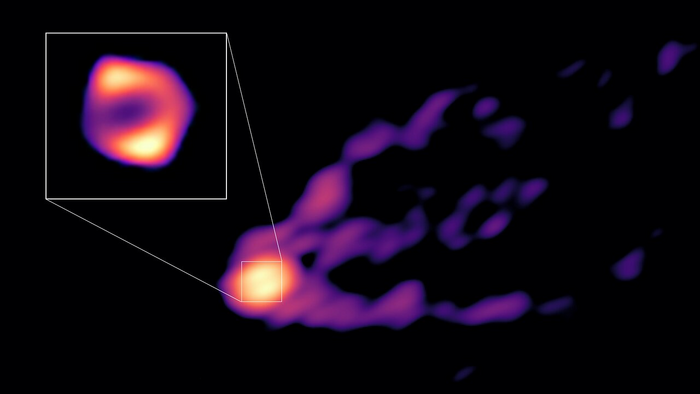Behold the first direct image of a supermassive black hole spewing a jet of particles
The first complete image of a black hole and its jet has captured a never-before-seen view of how the cosmic monster traps and spits out matter.

Astronomers have photographed a black hole spewing a powerful jet of material at near light speeds for the very first time.
The jet is being launched from around the event horizon (the point beyond from which no matter can escape) of the black hole M87*, the first black hole to ever be directly imaged. Located 53 million light-years away from Earth at the center of the galaxy Messier 87, M87* is supermassive — a cosmic monster as wide as our solar system and 6.5 billion times the mass of the sun.
By training a network of radio telescopes on the distant black hole, a team of researchers picked out the faint, long-wavelength radio signals given off by a blistering torrent of material spat from the cosmic monster's mouth, snapping the first ever image to display a black hole and its jet in the same frame. Their findings, published April 26 in the journal Nature, could offer scientists vital clues as to how extremely fast jets are made.
"We know that jets are ejected from the region surrounding black holes, but we still do not fully understand how this actually happens," lead-author Ru-Sen Lu, an astronomer at the Shanghai Astronomical Observatory, said in a statement. "To study this directly we need to observe the origin of the jet as close as possible to the black hole."
Black holes are born from the collapse of giant stars and grow by ceaselessly gorging on gas, dust, stars and other black holes in the star-forming galaxies that contain them. If black holes grow large enough, friction causes the material spiraling into their maws to heat up so much that it can outshine entire galaxies. (This hot, fast ring of material is called an accretion disk).
After circling the black hole's mouth, most of this material is subsequently spat out, forming a jet of hot gas and dust that, in roughly a tenth of instances, travels at 99.995% the speed of light.
Sign up for the Live Science daily newsletter now
Get the world’s most fascinating discoveries delivered straight to your inbox.
Astronomers believe these jets reach such incredible speeds with assistance from the black holes' rotation and their powerful magnetic fields, but none of this is known for certain. Precisely where around a black hole these jets originate is also a mystery.
To collect the new image, the researchers used radio telescopes from the Greenland Telescope (GLT), theGlobal Millimetre VLBI Array (GMVA) in Europe, and the Atacama Large Millimeter/submillimeter Array (ALMA) in Chile. By reconstructing the faint radio light they detected, the astronomers pieced together a jigsaw image of the black hole's silhouette, the swirling matter that surrounds it, and the hyper-fast jet of material that springs forth from it.
To the researchers' surprise, the ring of material around the black hole was 50% thicker than in the 2019 image of M87*, and a wider range of radiation was also seen being thrown out from its mouth, suggesting that just as material falls into the accretion disk, there could also be a particle wind blowing out. Whether these two new observations are related, and exactly where the jet is emerging from around the black hole, remains to be seen.
"We plan to observe the region around the black hole at the centre of M87 at different radio wavelengths to further study the emission of the jet," co-author Eduardo Ros, an astronomer at the Max Planck Institute for Radio Astronomy in Germany, said in the statement. "The coming years will be exciting, as we will be able to learn more about what happens near one of the most mysterious regions in the Universe."

Ben Turner is a U.K. based staff writer at Live Science. He covers physics and astronomy, among other topics like tech and climate change. He graduated from University College London with a degree in particle physics before training as a journalist. When he's not writing, Ben enjoys reading literature, playing the guitar and embarrassing himself with chess.









